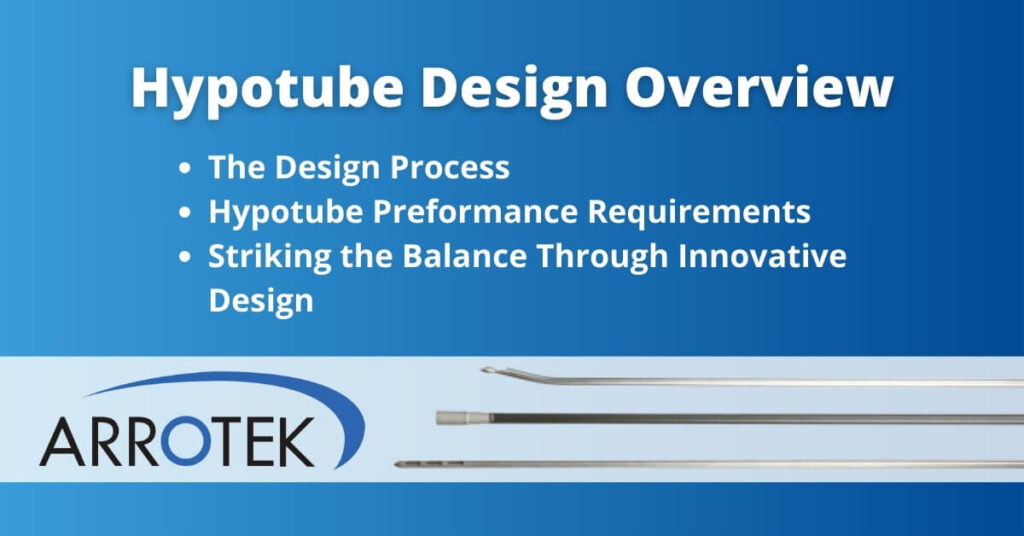The hypotube has been a feature of minimally invasive medical devices for some time now, including cannulas. Even though a range of different technologies is now available, they remain a critical component in many applications.
The core characteristic of a hypotube is that it needs to be hollow to enable the control of tools or for the delivery of balloons, stents, drugs, and other treatment or diagnostic technologies.
There is also an increasing need for hypotubes to be thin-walled to maximize the inner diameter while keeping the outer diameter small enough to proceed through small openings, navigate complex vasculatures, and reach hard-to-access parts of the body.
However, the above is just one area where innovation is taking place in hypotube design. In fact, innovation in hypotube design continues to advance at pace, making it possible to create new and novel medical devices that enhance the treatment of patients.
The Design Process
Regardless of the area of innovation, the role of the designer when developing a hypotube is to ensure it performs as expected while minimizing patient risks. Ensuring the overall device is financially viable is important too.
However, there is another important area of focus that applies to hypotubes: ensuring physicians have confidence in the device, particularly if it involves advanced technologies that push the boundaries of innovation.
For your new product to be successful, physicians need to have confidence the device, including the hypotube, is reliable, safe, and will perform as expected.
At its core, designing a hypotube involves determining a range of different characteristics. This includes:
- ID (internal diameter) and ID wall tolerance
- OD (outside diameter), OD wall tolerance, and whether the OD is tapered or constant
- Wall thickness
- The length the hypotube needs to be to get from the entry point on the body to the target treatment area
- The material used in its manufacture, such as stainless steel or nitinol
DFM considerations will be a part of the process, too, including designing for a continuous manufacturing process to not only reduce the cost of manufacturing the new device, but also to improve performance in areas like kink resistance (see below). Designing a laser-cut hypotube is another example of DFM, as laser-cut hypotubes can also increase kink resistance.
Performance requirements are also crucial considerations for the hypotube designer. One has already been mentioned above, i.e., kink resistance. There are others that have a similar level of importance.
Performance Requirements in Hypotube Design
Pushability
Pushability is the ability to transfer energy from the proximal end of the device (e.g., the handle) to the distal end (the tip). Pushability makes it possible to navigate the distal end of the hypotube, especially when force transfer at the proximal end correlates with an equal amount of movement at the distal end.
Torque
Torque is the ability of the hypotube to transmit a twisting force along its length. It has a strong connection with pushability and is about the transfer of rotational displacement from the proximal end of the device to the distal end.
Torque (as it applies to hypotubes) is typically expressed as a ratio. For example, a 1:1 ratio would mean the distal end of the shaft will rotate at the same angular rotation applied by the physician at the proximal end. This type of torque ratio makes it easier for physicians to navigate the distal end of the shaft to the target location in the body.
Trackability
Trackability is the ability of the shaft to progress through complex vasculatures in order to reach the target location. Trackability is influenced by things like the level of friction as it moves through the body and the flexibility of the shaft at the distil end.
There are a number of steps the designer can take to improve trackability. For example, using advanced coating technologies or applying an outer layer to the design to minimize friction
Kink Resistance
Hypotubes have a cross-sectional profile that is essential to the performance of the device. When the shaft kinks, such as when navigating a tight radius, this cross-sectional profile collapses.
Kinks occurring in a shaft compromise the performance of the device and can even cause the shaft to break. Therefore, optimising kink resistance for the specific application is a crucial consideration for engineers designing hypotubes.
Compression Resistance
When sufficient longitudinal force is applied to a shaft, it will compress. Hypotubes are exposed to longitudinal forces when inside the body, so engineers need to design the hypotube to ensure it has a sufficient level of compression resistance.
Flexibility
Flexibility is about the stiffness of the shaft, particularly when torque is applied. It is a performance requirement that influences many others i.e., a stiffer shaft will have higher compression resistance, but this is likely to be at the expense of trackability.
Transition
Transitions along the length of the hypotube are often an essential design consideration when developing novel, innovative medical devices.
Lubricity
Lubricity relates to the level of friction between the device and either the anatomy it is passing through or any companion device that is being used, such as a cannula. Lubricity is a key element in the trackability of the tube.
Exit Markers
Exit markers, such as brachial and femoral markers, help physicians navigate the shaft during procedures. How markers are added is also an important design consideration, as there are multiple methods that can be used, including lasers or printing.
Striking the Balance Through Innovative Hypotube Design
Designing a new hypotube isn’t about maximising each of the performance requirements mentioned above, as many are in direct conflict with others. For example, increasing stiffness will enhance pushability, but it will also reduce flexibility, i.e., the ability of the shaft to bend around a specified diameter.
Innovation in the design of hypotubes takes many forms, but a lot of the innovation comes down to optimising one performance requirement without negatively impacting another.
This type of innovation is enabling the development of hypotubes for some of the most advanced catheters and medical devices currently available. Excitingly, innovation in hypotube design is only set to continue.
Speak to an Engineer
To speak to an engineer about hypotube design in relation to a project you are working on, please get in touch with a member of our team today.





